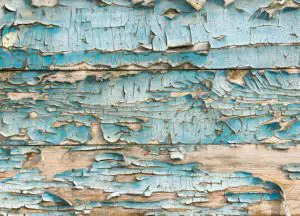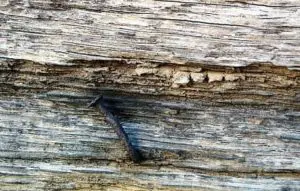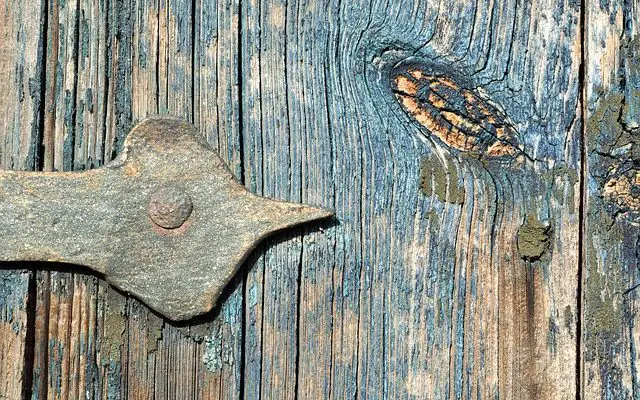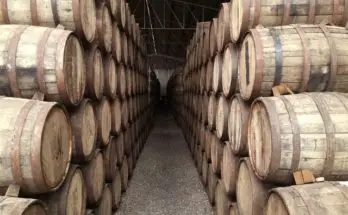With the popularity of using reclaimed wood over the past few years in everything from counter tops to home décor to flooring people have become very comfortable with buying it. It’s not often though that I hear people pause long enough to question whether or not it is safe to use.
For the most part, reclaimed wood is safe to use in your home, but like anything, there are precautions that need to be taken to ensure the wood you are using is safe. Below we will explore some of the instances of when reclaimed wood may not be safe for you to use and what you can do to reduce the risk of using unsafe wood in your projects.
What is considered reclaim wood?
The first thing to consider before looking at whether or not reclaimed wood is safe for you to have in your home is to understand what it is and where it comes from. The term “reclaimed wood” is a very broad category.
The very basics of the definition is that it is wood that has been repurposed to be used as something else. Based on this definition, reclaimed wood could be an old deck, barn, fence, bowling alley or even dog house that has been torn apart and the wood prepared to be used as something else. You may be surprised to see that reclaimed wood can come from some of these sources. This is the reason that it’s impossible to give an absolute answer that all reclaimed wood is safe.
Bugs
The most common issue that you are likely to encounter when buying or using reclaimed wood is the presence of bugs or insects. If you think about it, reclaimed wood, no matter the source has likely been sitting in a location and exposed to elements for quite some time. This makes it the prime spot for insects such as termites, beetles and spiders to make their homes.

Fortunately, there are steps you can take to ensure that the reclaimed wood you are bringing into your home is bug free. For a more detailed look at treating your reclaimed lumber for bugs, take a look at the article that I wrote here. The safest (and easiest) way to ensure the wood you purchased is bug free is to buy from a source that has the ability to send their lumber a heated kiln. When done properly, the heat from the kiln will kill all bugs and any eggs that may be inside the wood. The problem is that many resellers of reclaimed wood don’t have the money, space or even interest in running all their lumber thru a kiln. Even if the wood has been sent thru a kiln, you are having to trust someone that you’ve likely never met and hope they did it properly.
The do it yourself method for eliminating any bugs in your wood is to use chemicals. It’s very straightforward and inexpensive. I always treat any reclaim wood that I get just for peace of mind. The article I wrote and linked above has all the products and details of what you need to do the job. The entire process can be completed in an hour or so depending on how much lumber you have to treat. In addition, you only need to purchase two things – the chemical and an applicator which can be a paint brush or pressure sprayer.
Nails and other material
If you are purchasing reclaimed wood with the intentions of making signs and not cutting the material, this won’t be a major issue for you. If you do plan to cut your wood with any saws, I highly recommend at the very least to looking over the wood very closely to ensure it is free of any stray nails or other pieces of metal. Cutting thru a piece of wood that has a stray nail will not only give you a quick scare, but there’s a high probability that it will mess up the blade of your saw as well.
Personally, I always run a basic magnet over my wood because making any cuts. You’d be surprised at how many small pieces of metal can be hidden in the wood that you don’t see when looking over it.
Lead Paint
Another danger that you many people don’t consider is lead paint. Since many people use reclaimed wood because of the character and weathered look that is get over time, most of the wood that is used is several decades old. Many people do not realize that the United States  government banned the use of lead paints in buildings and homes built after 1977. Currently numbers estimate that approximately 38 million homes (or 30% of all homes) in the United States were built before 1978, which puts them at high risk for lead paint.
government banned the use of lead paints in buildings and homes built after 1977. Currently numbers estimate that approximately 38 million homes (or 30% of all homes) in the United States were built before 1978, which puts them at high risk for lead paint.
Most of the reclaim wood that is purchased comes from other sources than homes, but if a third of all homes in the US were built before the lead paint ban, it is easy to assume that the number of other structures (barns, bowling alleys, railroad boxcars) is much higher. Fortunately, there are inexpensive tests kits that you can use on wood before bringing it into your home. You can pick up a basic kit that will test the wood here on Amazon that will allow you to test multiple items.
Lead poisoning is most prevalent in children of the ages of 5 and younger. The reason for this is that the lead paint is much more likely to flake off and fall to the floor where children will pick it up and put it in their mouths. Lead poisoning can also occur in dust particles that float thru the air as well. The slightest amount of lead in your body can cause serious problems.
Chemicals
Another important aspect to reclaim wood that I feel gets overlooked most is the chemicals that could be contained within the wood. Since the wood is often decades old, it is impossible to know for sure if chemicals were used on it. This is especially true when it comes to using pallet wood in your projects. The use of pallet wood in home projects is extremely popular because the wood is often very cheap, has a weathered look and is usually made of oak which is a nice hardwood.
The problem with pallet wood is the chemicals that can be used to treat it for bugs. The absolute safest way to determine if a pallet is safe to use is to check for the markings on it. Often, pallets are marked by burning certain numbers or letters on the wood to indicate how it has been treated.
If you find a pallet that has been market with “HT” it indicates that the wood has been heat treated and no chemicals have been used. Buying pallet wood when the pallet has already been disassembled usually makes this check near impossible. If you come across a pallet that has no markings, it is recommended that you not use it because it’s not possible to know how it was treated in the past.
How I prepare my wood
Here is a high level walk thru of how I prepare my reclaimed wood for use. I typically buy 200-300 feet of wood at a time, so the amount of wood I’m prepping may be significantly more than you, but the overall process can easily be followed if you only have a couple small boards.
I live in a great area for getting old wood. I have a major city nearby which creates a demand for reclaimed lumber so there are always sellers. Plus I’m close enough to the country where there are numerous barns available so supply is never a problem. Unfortunately, I’ve not been able to find a reasonably price supplier that has a kiln.
Step 1 – Setup
The very first thing I do is check the upcoming weather forecast. I take my time on this whole process to ensure everything dries properly, so this usually takes 2-3 days depending on the temperature outside. Once I’ve confirmed sunny weather, I lay out all my boards so I can wash them. I try to lay them vertically against the house or shed if possible but laying them on the ground is fine too. If you prop them against your house, just know that your house will get dirty and will need a quick wash down when you are done.
As I’m unstacking the boards and laying them out, I have a hammer and trash can nearby so I can remove any nails that I come across. I’m not concerned about getting every nail at this point, but I grabbing the obvious ones. During the time that I’m laying out the boards, I also look over them for any that paint that may need to be tested for lead. If I have some (I don’t buy painted wood often), I set them aside and use the test kit that I referenced above.
Step 2 – Wash
Next on my list is to wash all the wood with a pressure washer. I go over the wood slowly and really try get all the dirt out. You’ll be amazed at much dirt can be hidden within the cracks and cervices of the wood. As I’m washing, I start at a top corner and work my way down so all the dirt flows down and I don’t have to rewash. Once I’ve washed all my boards, I flip them over and do the same to the other side. After this step, you are done.
Hopefully your boards are in view of the sun. Depending on the thickness of my boards, I do sometimes go outside and flip the boards over every few hours so both sides of the wood get some exposure to the sun. Depending on the sun exposure and temps, the wood will usually be dry within a day or two.
Step 3 – Bug Treatment
Once all the boards have dried, and while they are still laying out, I will do my bug treatment. This step isn’t as difficult as it sounds. I always use Bora-Care which you can find here. A gallon of it will treat quite a bit of wood. You can apply it using a paint brush if you don’t have much wood to treat, or you can do like me and pick up a pressure sprayer. Using the sprayer is easiest for me, because I just spray one side of the boards and then let them dry.
Once dry, I flip them over and repeat. Bora-Care is nice because it not only kills bugs that have been present but also helps prevent any new ones from deciding to make your wood their new home.
Step 4 – Check for metal
When I first started using reclaimed wood, I didn’t complete this step. However, I soon learned  the hard way (via a saw blade) that metal is often hidden in these old reclaimed boards. Once the wood has dried from the Bora-Care treatments, I run a magnetic stud finder over the boards one at a time. I use this basic magnetic stud finder from Amazon. It has helped me find numerous little pieces of wood that I would not have seen with my naked eye. Once I’m confident the wood is bug and metal free, I stack the wood in my shop. I always put the longest boards on the bottom and stack from there. Then I just pull from the stack when I’m ready to use them.
the hard way (via a saw blade) that metal is often hidden in these old reclaimed boards. Once the wood has dried from the Bora-Care treatments, I run a magnetic stud finder over the boards one at a time. I use this basic magnetic stud finder from Amazon. It has helped me find numerous little pieces of wood that I would not have seen with my naked eye. Once I’m confident the wood is bug and metal free, I stack the wood in my shop. I always put the longest boards on the bottom and stack from there. Then I just pull from the stack when I’m ready to use them.
Conclusion
As you can see, it’s not really possible to give a definitive answer to the question “Is reclaim wood safe?” There are many factors that can influence the answer to that question. However, in my experience, if you do the proper prepping of the wood beforehand you can greatly reduce any risk of your wood not being safe to have in your home.




